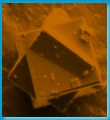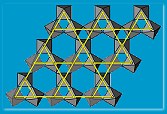Frustrated Magnets
By: David Bradley
 Scientists sometimes take magnetism for granted. But some materials behave
badly and scientists funded by the UK's Engineering and Physical Sciences
Research Council (EPSRC) are trying to find out why. They are looking at
the conventional wisdom of modern theories and finding it does not always
stick to exotic magnets.
Scientists sometimes take magnetism for granted. But some materials behave
badly and scientists funded by the UK's Engineering and Physical Sciences
Research Council (EPSRC) are trying to find out why. They are looking at
the conventional wisdom of modern theories and finding it does not always
stick to exotic magnets.
Scientists from archaeologists to zoologists are attracted to magnetic
measurements. Archaeologists use magnetic artefacts to date sites, while a
zoologist might be investigating the effects of magnetism on bird brains.
Magnetism is fundamental to science, but despite their ubiquity scientists
still cannot fully explain magnetic materials.
Professor of Solid State Chemistry at Edinburgh University, Andrew
Harrison hopes with the help of EPSRC funding to get inside some exotic
magnets, which could provide insight into more common magnetic materials
and ultimately help in the design of computer memory and electrical
devices. "The study of the fundamental properties of magnets gives us
valuable insights into the principles that govern the structure of
solids," he explains, "This has implications that stretch beyond magnetism
and into superconductivity."
The conventional picture of a magnet says each atom in a material acts like a tiny magnet. The magnetic moment, or direction of the North-South divide on the atoms line up parallel (in permanent ferromagnets like iron) or anti-parallel in an up-down arrangement in antiferromagnetic materials, such as manganese oxide. "The reason why such materials behave this way," says Professor Harrison, "is that below a certain critical temperature the magnetic moments 'freeze', or become locked in position." For an iron magnet this critical temperature is well above room temperature but for other materials they have to be cooled near to absolute zero before they become magnetic. The picture was fairly simple until high-temperature cuprate superconductors were discovered and started throwing up strange results. For instance, some of these materials, at first sight seemed not to have frozen magnetic moments. Such findings inspired researchers to seek new understanding of magnetic materials.
 Because the magnetic moments in some superconducting magnets were very
small, quantum fluctuations in their orientation overpower the usual
forces that normally lock the magnetic moments in place. In the case of
lanthanum cuprate, this is not quite enough to upset the conventional
picture but a new ingredient - frustration - changes completely the
conventional picture. Frustration is found in materials where the magnetic
moments are on a triangular rather than a square lattice. "You cannot
physically align all the moments antiparallel with their neighbours!" says
Harrison. In such a 'frustrated' lattice, the conventional forces between
magnetic moments are much reduced and the quantum fluctuations are more
influential. This kind of magnet may never freeze and the material
fluctuates between different states with the moments twitching between the
sides of the triangles. The result is that the material exists as a "spin
fluid" and such materials could help explain magnetism and possibly
superconductivity.
Because the magnetic moments in some superconducting magnets were very
small, quantum fluctuations in their orientation overpower the usual
forces that normally lock the magnetic moments in place. In the case of
lanthanum cuprate, this is not quite enough to upset the conventional
picture but a new ingredient - frustration - changes completely the
conventional picture. Frustration is found in materials where the magnetic
moments are on a triangular rather than a square lattice. "You cannot
physically align all the moments antiparallel with their neighbours!" says
Harrison. In such a 'frustrated' lattice, the conventional forces between
magnetic moments are much reduced and the quantum fluctuations are more
influential. This kind of magnet may never freeze and the material
fluctuates between different states with the moments twitching between the
sides of the triangles. The result is that the material exists as a "spin
fluid" and such materials could help explain magnetism and possibly
superconductivity.
According to Harrison, however, materials that have a small magnetic
moment in a frustrated lattice are very rare and have proved difficult to
synthesize. "Such a material is one of the Holy Grails in this area of
science" he muses There are many materials with triangular lattices, such
as vanadium(II) chloride, but they have conventional magnetism. "The
challenge is to swap the elements such as vanadium, which have relatively
large atomic moments, for magnetic copper ions, which have small atomic
moments, while retaining a triangular lattice. So far the wrong lattice
forms," adds Harrison, "It's as if nature doesn't want to produce such a
material with this kind of unstable ground state, what happens is that the
magnet distorts to some other form as it cools down."
Harrison and collaborators have tried an alternative material type over
the last few years. A material of chemical formula ABO2 (A and B are two
different metals, O2 is oxygen) can crystallize with the rock salt, sodium
chloride NaCl, structure but instead of Na-Cl-Na-Cl
material type over
the last few years. A material of chemical formula ABO2 (A and B are two
different metals, O2 is oxygen) can crystallize with the rock salt, sodium
chloride NaCl, structure but instead of Na-Cl-Na-Cl